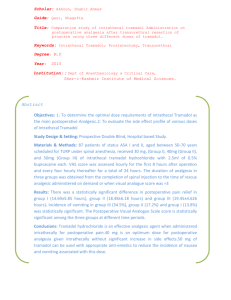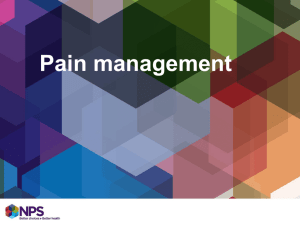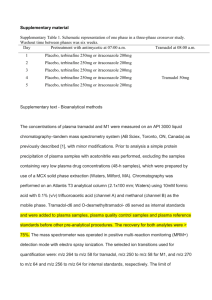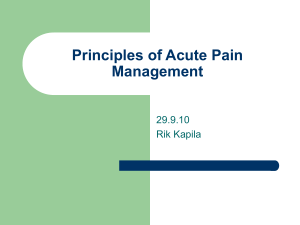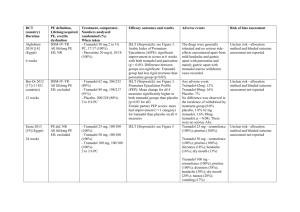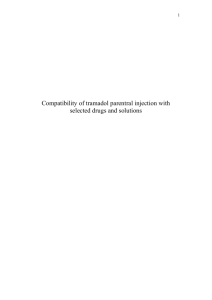Additional file 1 - By-criterion health technology
advertisement
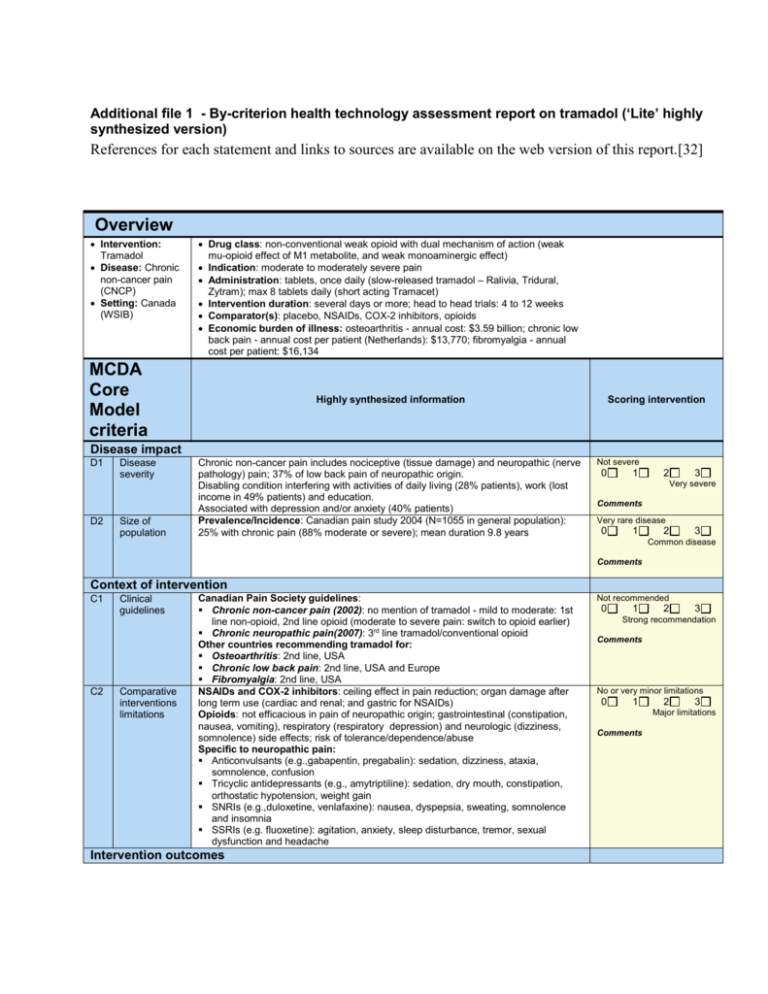
Additional file 1 - By-criterion health technology assessment report on tramadol (‘Lite’ highly synthesized version) References for each statement and links to sources are available on the web version of this report.[32] Overview Intervention: Tramadol Disease: Chronic non-cancer pain (CNCP) Setting: Canada (WSIB) Drug class: non-conventional weak opioid with dual mechanism of action (weak mu-opioid effect of M1 metabolite, and weak monoaminergic effect) Indication: moderate to moderately severe pain Administration: tablets, once daily (slow-released tramadol – Ralivia, Tridural, Zytram); max 8 tablets daily (short acting Tramacet) Intervention duration: several days or more; head to head trials: 4 to 12 weeks Comparator(s): placebo, NSAIDs, COX-2 inhibitors, opioids Economic burden of illness: osteoarthritis - annual cost: $3.59 billion; chronic low back pain - annual cost per patient (Netherlands): $13,770; fibromyalgia - annual cost per patient: $16,134 MCDA Core Model criteria Highly synthesized information Scoring intervention Disease impact D1 D2 Disease severity Size of population Chronic non-cancer pain includes nociceptive (tissue damage) and neuropathic (nerve pathology) pain; 37% of low back pain of neuropathic origin. Disabling condition interfering with activities of daily living (28% patients), work (lost income in 49% patients) and education. Associated with depression and/or anxiety (40% patients) Prevalence/Incidence: Canadian pain study 2004 (N=1055 in general population): 25% with chronic pain (88% moderate or severe); mean duration 9.8 years Not severe 0 1 2 3 Very severe Comments Very rare disease 0 1 2 3 Common disease Comments Context of intervention C1 C2 Clinical guidelines Comparative interventions limitations Canadian Pain Society guidelines: Chronic non-cancer pain (2002): no mention of tramadol - mild to moderate: 1st line non-opioid, 2nd line opioid (moderate to severe pain: switch to opioid earlier) Chronic neuropathic pain(2007): 3rd line tramadol/conventional opioid Other countries recommending tramadol for: Osteoarthritis: 2nd line, USA Chronic low back pain: 2nd line, USA and Europe Fibromyalgia: 2nd line, USA NSAIDs and COX-2 inhibitors: ceiling effect in pain reduction; organ damage after long term use (cardiac and renal; and gastric for NSAIDs) Opioids: not efficacious in pain of neuropathic origin; gastrointestinal (constipation, nausea, vomiting), respiratory (respiratory depression) and neurologic (dizziness, somnolence) side effects; risk of tolerance/dependence/abuse Specific to neuropathic pain: Anticonvulsants (e.g.,gabapentin, pregabalin): sedation, dizziness, ataxia, somnolence, confusion Tricyclic antidepressants (e.g., amytriptiline): sedation, dry mouth, constipation, orthostatic hypotension, weight gain SNRIs (e.g.,duloxetine, venlafaxine): nausea, dyspepsia, sweating, somnolence and insomnia SSRIs (e.g. fluoxetine): agitation, anxiety, sleep disturbance, tremor, sexual dysfunction and headache Intervention outcomes Not recommended 0 1 2 3 Strong recommendation Comments No or very minor limitations 0 1 2 3 Major limitations Comments I1 I2 I3 Improvement of efficacy/ effectiveness Improvement of safety & tolerability Improvement of patient reported outcomes Trial results obtained with WOMAC and other scales were recalculated to be expressed on a normalized scale from 0 (minimum improvement) to 100 (maximum improvement). If not mentioned, no significant difference 5 Head to head randomized controlled trials (osteoarthritis, low back pain & other; 4 to 12 weeks; N =108 to 1001; 1 in Canada, 4 in USA): Pain intensity reduction from baseline: tramadol: 15-24; diclofenac: 16; celecoxib: 26 (P=0.05 vs placebo); placebo: 19 (significant difference for all vs baseline) Pain intensity reduction after 6 hrs: tramadol: 21; codeine: 18 Placebo randomized controlled trials (Cochrane reviews): Pain intensity reduction versus placebo: 8.5 (osteoarthritis, 3 trials, N= 92 to 307) 10.8 (chronic low back pain, 3 trials, N= 254 to 336) Patients achieving 50% pain relief: 63% tramadol vs 37% placebo (neuropathic pain, 3 trials, N=67 to 127) Summary of common AEs (> 5% of patients in RCTs and frequency > twice of placebo in tramadol product monographs): nausea: tramadol 10–24%; codeine 5–19%; diclofenac 11% somnolence: tramadol 7–18%; codeine 3–24%; diclofenac 8% dizziness: tramadol 7–24%; codeine 5–14%; diclofenac 18% constipation: tramadol 7–21%; codeine 10–21%; diclofenac 15% vomiting: tramadol 4–15%; codeine 1–7%; diclofenac 5% dry mouth: tramadol 5%, diclofenac 7% sweating: tramadol 1–15%; codeine 1%; diclofenac 0% Warnings tramadol: Seizure risk; anaphylactoid reactions, drug abuse, addiction and dependence; withdrawal symptoms; risk of overdosage; increased intracranial pressure or head trauma; respiratory depression Drug abuse: 12 month study: tramadol 2.7%, NSAIDs: 2.5%; hydrocodone: 4.9% Surveillance study: tramadol: 0.5–2 cases/100,000 patients (over 10 years); oxycodone: at least 5/100, 000 cases (over 3 years) Trial results obtained with WOMAC and other scales were recalculated to be expressed on a normalized scale from 0 (minimum improvement) to 100 (maximum improvement). If not mentioned, no significant difference 3 Head to head RCTs (osteoarthritis studies; 6 to 12 weeks, N=108 to 1001, 1 in Canada, 2 in USA): Physical function improvement from baseline: tramadol: 15-21, diclofenac: 15, celecoxib: 25 (P=0.05 vs placebo), placebo: 17 Stiffness reduction from baseline: tramadol: 17, diclofenac: 18 Quality of sleep improvement from baseline: tramadol: 10, diclofenac: 8 (P< 0.05 for all vs baseline; in 1 trial, no numbers reported for stiffness and quality of sleep but significance reported for tramadol300 mg vs placebo and for celecoxib vs placebo) Lower than comparators Risk of depression: The degree of depression improvement correlates with the amount of pain relief. Pain relief with tramadol may therefore have an impact on the risk of depression (no data available) No risk reduction 0 1 2 3 Major improvement Comments Lower than comparators 0 1 2 3 Major improvement Comments Lower than comparators 0 1 2 3 Major improvement Comments Type of benefit T1 Public health interest 0 1 2 3 Major risk reduction Comments T2 Type of medical service Tramadol produces symptom relief (20 points from baseline on a scale from 0 to 100) and may improve physical function, but does not cure pain Minor service 0 1 Comments Economics 2 3 Major service (e.g.cure) E1 E2 E3 Budget impact on health plan Costeffectiveness of intervention Impact on other spending Average daily cost per patient (based on historical claims data): Tramadol: $2.24–2.27 (long-acting) to $2.91 (short acting) Comparators: NSAIDs: $0.11–0.80 COX-2 inhibitor: $1.58 Opioids: $0.67–6.61 Antidepressants: $0.61–8.77* SNRIs: $2.66–8.77* Anticonvulsants: $5.39–7.23* *Based on maximum dose Based on budget impact models for private drug plans Annual impact on budget for pain control (average % over 3 years): Model 1: +0.27% Model 2: -0.32%; highly sensitive to average dose of tramadol (+2.08% for RCT doses; base case with US market doses) Drugs included in models: NSAIDs, COX-2 inhibitor, codeine, stronger opioids and Zytram; (plus meloxicam, acetaminophen in model 2); (plus slow release tramadol in model 1) Incremental cost (drug and adverse events) per patient over 6 months (based on cost-minimization study by Liedgens): Tramadol vs NSAIDs only: +$179 Tramadol vs NSAIDs+ proton pump inhibitors (PPIs): -$110 (savings) Tramadol vs NSAIDs+ histamine receprot antagonists (H2RAs): +$66 Adverse events included for tramadol: constipation, nausea, vomiting, vertigo, somnolence, and others Adverse events included for NSAIDs: gastrointestinal distress, serious complications, ulcer, anemia from occult bleeding Sensitivity analysis: when including renal adverse events due to NSAIDs, savings with tramadol vs NSAIDs from $345 to $631 Impact on adverse events expenditures per patient over 6 months: (excluding drug cost, including all adverse evnts in Liedgens study) Tramadol vs NSAIDs only: -$567 (savings) Tramadol vs NSAIDs+ PPIs: -$534 (savings) Tramadol vs NSAIDs+H2RAs: -$574 (savings) No data versus other comparators, no data on other spending (e.g. disability) Substantial additional spending 0 1 2 3 Substantial savings Comments Not cost-effective 0 1 2 3 Highly cost-effective Comments Substantial additional spending 0 1 2 3 Substantial savings Comments Quality of evidence Q2 Q3 Completeness and consistency of reporting evidence Relevance and validity of evidence Clinical data: 5 trials: overall consistent reporting within studies but some issue in completeness of reporting including: no numerical data for efficacy (1 trial) or safety (1 trial), type of analysis unclear (1 trial), data collection schedule unclear (1 trial); Economic evaluation (1 cost-minimization study): overall consistent reporting within study but some issues in completeness of reporting including: no disaggregated data regarding resource utilization and associated costs, sensitivity analyses data reported for only one parameter Clinical data – 5 trials: a number of issues regarding validity and relevance including: short trial duration for chronic treatment (4 trials ≤ 6 weeks), data mostly in older osteoarthritis patients, most data for short-acting tramadol (3 trials), interpretation of results difficult (2 trials), high attrition rate (> 20% in 3 trials); efficacy measure (4–6 hrs after treatment) not relevant for chronic pain (2 trials) Economic evaluation (1 cost-minimization study): a number of issues regarding validity and relevance including: Dutch setting; only NSAIDs as comparators; only adverse events considered (not consequences of these); short duration for chronic disease (6 months); only medical costs considered Contextual Tool criteria Highly synthesized information Many gaps/inconsistent 0 1 Goals of healthcare – utility* Goal of healthcare: maintain normal functioning. Pain has a major impact on functioning and relieving pain is an ethical duty Et2 Opportunity costs – efficiency* Maximizing impact on health for a given level of resources at: Patient level: tramadol offers another option for pain relief but is more expensive than most other analgesics Population level: Interest in using resources to treat underlying disease/condition rather than symptoms Prioritize worst off: Chronic pain has major ramifications for patients, family and Low relevance/validity 0 1 Population 2 3 High relevance/validity Comments Impact on appraisal & comments Negative None Positive Comments Et3 3 Comments Ethical framework* Et1 2 Complete & consistent Negative None Positive Comments Negative priority & access – fairness* society. Tramadol provides another option to tackle widespread undertreated chronic pain Treat like cases similarly: Should chronic non-cancer pain be treated differently than cancer pain? Access to care/treatment: barriers for prescribing opioids (fear of addiction and of regulatory scrutiny), critical in general practice None Positive Comments Other components O1 O2 O3 System capacity and appropriate use of intervention Stakeholder pressures Political /historical context Risk of abuse of opioids and difficulty to control abuse; standardized guidelines to limit abuse (mainly ensure non-opioid failed, single pharmacy/doctor and comprehensive follow-up) not always applicable in busy practices or complex cases Abuse rates: lower for tramadol than for hydrocodone Negative None Positive Canadian Pain Society: clinician pressures on Health Canada to keep tramadol out of the controlled drug schedule on the basis that it is a good option for moderate pain and associated with less abuse than other opioids. Currently, tramadol is not scheduled in Canada WHO committee concluded that, based on low level of abuse, there was not sufficient evidence to justify a review. WHO reports some evidence of smuggling and diversion of tramadol but no evidence of illicit manufacture; CEDAC recommendation: do not list; Other workplace insurance boards: reimbursement of tramadol case specific. Negative None Positive Comments Comments Negative None Positive Comments
